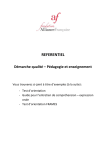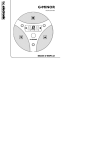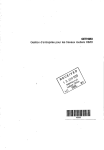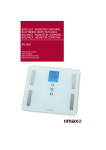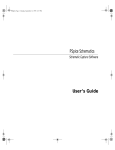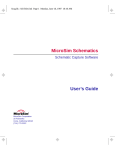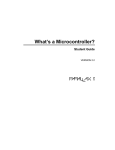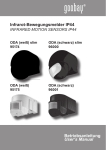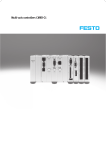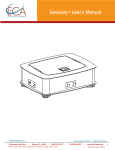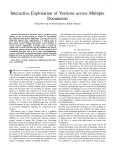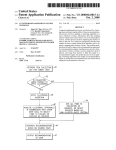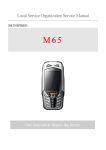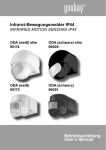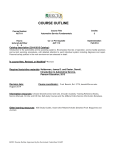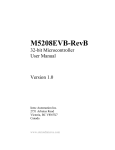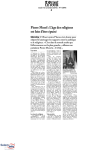Download MAE 151 Music Box Design Binder
Transcript
MAE 151 MUSIC BOX DESIGN BINDER:
LION KING CHRONICLES
Group 31: Henry, Thomas, Kushal, Eric, Fady
Presented by: Lion King Group (Group #31)
COMPANY: DESIGN WORKS
5200 ENGINEERING HALL
IRVINE, CA 92697-2700
MAE 151: Music Box Design Binder
TABLE OF CONTENT
Phase 1: Concept Development .................................................................................................................... 3
SECTION 1: PROBLEM FORMULATION.................................................................................................................................4
Process of Problem FormulaƟon: .......................................................................................................................... 5
Customer Need Survey: .........................................................................................................................................5
Customer Need Survey Results: .............................................................................................................................6
Customer Need Summary: ....................................................................................................................................7
SECTION 2: PROJECT DEFINATION .....................................................................................................................................8
Goal Statement .....................................................................................................................................................9
Code of Ethics ......................................................................................................................................................10
Preliminary Project GanƩ Chart ..........................................................................................................................11
Music Box Needs Metrics Matrix ........................................................................................................................12
SpecificaƟon Sheet ..............................................................................................................................................13
Projected Timeline and Task Assignments for the Project ..................................................................................16
Brainstorming / Concepts GeneraƟon ................................................................................................................18
SECTION 3: STRUCTURE DESIGN CONCEPT ........................................................................................................................20
Music Box Structure Design Process Summary ...................................................................................................21
Structure MathemaƟcal Model: ..........................................................................................................................22
Math Model Results and Comparisons: ..............................................................................................................23
Design Concepts: .................................................................................................................................................24
DownselcƟon .......................................................................................................................................................34
Structure Design JusƟficaƟon: .............................................................................................................................35
Structure Design FEA Results: .............................................................................................................................36
Structure Design BOM:........................................................................................................................................36
SECTION 4: BALL RAMP / DETECTION / CATCH – RELEASE DESIGN CONCEPT ...........................................................................37
Music Box DetecƟon, Catch and Release Concept Development Summary ........................................................38
Ball Drop KinemaƟcs MathemaƟcal Model ........................................................................................................39
Detailed Design Concepts: ..................................................................................................................................40
DownselcƟon .......................................................................................................................................................44
Servo Speed MathemaƟcal Model: .....................................................................................................................47
SECTION 5: THEME / SPEAKER / ELECTRONIC ENCLOSURE/ SOUND PRODUCTION DESIGN CONCEPT ...........................................49
Theme Design Concept:.......................................................................................................................................50
Speaker Design Concept:.....................................................................................................................................50
Arduino Enclosure Design Concept: ....................................................................................................................51
Sound ProducƟon Design Concept: .....................................................................................................................52
Down SelecƟon....................................................................................................................................................52
SECTION 6: MUSIC ASSIGNMENT DESIGN FOR PROGRAMMING .............................................................................................53
Developing Music Notes: ....................................................................................................................................54
Development of Notes Assigned to Group: .........................................................................................................56
SECTION 7: TIMING CONCEPT .........................................................................................................................................57
AnalyƟcal Model for Timing ................................................................................................................................58
SECTION 8: COMPLETE CONCEPT DESIGN (BOM) ..............................................................................................................59
Rough BOM of Concept Design ...........................................................................................................................60
Phase 2: Prototype Development ............................................................................................................... 61
SECTION 1: STRUCTURE FABRICATION .............................................................................................................................. 62
SECTION 2: BALL RAMP / DETECTION / CATCH - RELEASE FABRICATION..................................................................................65
SECTION 3: SPEAKER BOX / ARDUINO BOX FABRICATION ....................................................................................................68
SECTION 4: WIRING DIAGRAM........................................................................................................................................72
SECTION 5: PROGRAMMING ...........................................................................................................................................77
1|Page
MAE 151: Music Box Design Binder
Phase 3: Tes ng – Redesign – tes ng ......................................................................................................... 83
SECTION 1: PROTOTYPE TESTING.....................................................................................................................................84
SECTION 2: REDESIGN ...................................................................................................................................................86
SECTION 3: FINAL PRODUCT PROTOTYPE ..........................................................................................................................91
SECTION 4: FINAL PROTOTYPE FIT TESTING .......................................................................................................................94
Final Product ............................................................................................................................................... 96
SECTION 1: FINAL BIG STACK PICTURES ............................................................................................................................97
SECTION 2: FINAL WIRING DIAGRAM ............................................................................................................................. 100
SECTION 3: FINAL DRAWINGS .......................................................................................................................................103
SECTION 5: FINAL BOM ..............................................................................................................................................121
SECTION 5: MANUAL ..................................................................................................................................................124
Appendix ................................................................................................................................................... 132
SECTION 1: STATUS REPORTS .......................................................................................................................................133
SECTION2: TEAM MEMBER CONTRIBUTIONS ...................................................................................................................143
2|Page
MAE 151: Music Box Design Binder
PHASE 1: CONCEPT DEVELOPMENT
3|Page
MAE 151: Music Box Design Binder
SECTION 1: PROBLEM FORMULATION
4|Page
MAE 151: Music Box Design Binder
Process of Problem Formula on:
In order to define the project defini on, first the problem was formulated. The primary problem
that was formulated for the project was to design a music box that incorporated ball drop according to
customer needs. As a result, the customer need survey was developed and shared throughout the
social media to obtain variety of samples of the market. Then, this survey was analyzed and project
goal statement and objec ves were developed around customer needs.
Customer Need Survey:
This survey was published on the social media websites as twi er and Facebook
5|Page
MAE 151: Music Box Design Binder
Customer Need Survey Results:
6|Page
MAE 151: Music Box Design Binder
Customer Need Summary:
Team was able to narrow down what customers wanted in a music box through the use of an online
survey. Throughout the course of a few weeks, approximately 50 people took the survey. From the
survey, it was concluded that 44% of the people would like the speaker to be able to be heard 10 feet
away, 49% would like the music box to have a Lion King theme, 41% would buy the completed box for
$30 - $40 dollars, 59% of the people would like the music box to be made of wood, and 64% would
choose reliability as the number one priority of the music box. A er analyzing and tabula ng data, it
was concluded that the following will be customer needs for our music box:
-
Lion King Theme
-
Wood Material
-
Sound loud enough to be heard 10 feet away
-
Crisp and clear sound
-
Cater to Teens and Preteens; Lovers of The Lion King movie
-
Ages 8 – 21 – Majority Survey Takers were in this age range
-
Sturdy; Able to handle large loading
-
Mul ple music box compa bility
7|Page
MAE 151: Music Box Design Binder
SECTION 2: PROJECT DEFINATION
8|Page
MAE 151: Music Box Design Binder
Goal Statement
The goal of this project is to create, design and fabricate a music box that incorporates the
theme of customer’s choice with the wondrous music created by Composer Dunn-Rankin. The music
box will be designed and constructed from scratch, and will be tested for performance before its final
design and then final product will be fabricated and presented. In addi on, the music box will be
designed and programmed in such way that this music box can be integrated into the music box to play
a full song with other boxes. In conclusion, this box will sa sfy two major requirements: reliability and
needs of the customer.
Target audience for this music box are young children in their teens and preteens. The needs of
these customers will be determined from method of online survey. Using this survey results, customer
needs and specifica ons will be developed. Our team thinks that a loud and crisp sound produced and
lights lit from the music box will entertain children and teens ages 8 to 21 years. In addi on, the
background of the music box adds a nice theme to any loca on the customer decides to put the music
box. The team also understands that teens and preteens can have reckless tendencies and therefore
has also designed the music box to be durable and not collapse or distort under various loadings.
Objec ves
1. Produce design concepts and solu ons with the specifica ons and customer needs
2. Down select the design solu ons
3. Fabricate a prototype of the selected design
4. Produce electronics and program the controls of the box.
5. Test and Redesign
6. Final Test and Final Presenta on
9|Page
MAE 151: Music Box Design Binder
Code of Ethics
x
A er developing goal statement, code of ethics, presented below was developed.
I. Professional Obliga ons
Group Lion King shall comply with the customer needs with the highest standards of honor and
integrity.
a. Customer needs shall not be altered or distorted if data results are unfavorable.
b. All ac ons of the Group Lion King shall be recorded and documented weekly in the form of status
reports.
c. Group Lion King shall use equipment best fit for the music box as long as it does not conflict with
the customer needs or interests.
II. Safety
Group Lion King shall hold paramount the safety, health, and welfare of those involved in the
project.
a. Group Lion King shall abide by lab rules of the room when working in the lab; failure to do so will
result in leave of lab sta on.
b. Safety goggles and closed toe shoes shall always be worn as well as sleeves rolled up. Failure to
comply will result in leave of lab.
c. If a group member’s ac on(s) is overruled under circumstances that endanger life or project, a
different method shall be used to complete the ac on.
d. Group Lion King shall always use the safest method to manufacture and build the music box.
III. E que e
Group Lion King shall treat each other with mutual respect and work together to complete
the music box.
a. If an issue arises, the ma er will be dispute in an orderly fashion amongst group members.
b. A end weekly mee ngs with group and the teaching assistant. If a group member cannot make
it, it is their job to be up to date with project informa on.
c. Construc ve cri cism and honest feedback is recommended and welcome. Listen to what other
group members have to say to ensure best results for music box.
d. Addi on mee ngs may be schedule if necessary to promote project. Try and find suitable mes
for all group members if all need to a end.
IV. Time Management
Group Lion King shall assign tasks equally to each of the group members.
a. Group Lion King shall complete assigned tasks by the due date. If they are unable to complete the
assigned task by the due date, they shall state when they may complete the assigned task.
b. Group members will help each other complete assignments to meet deadlines and move the
project ahead.
c. Don’t take on the responsibility of too many tasks if one is unable to complete all of them by the
due date.
10 | P a g e
Preliminary Project Gan Chart
11 | P a g e
MAE 151: Music Box Design Binder
Customer Needs
Loud and
Crisp Sound
Made of
Wood
Lion King
Theme
x
x
Reliability
Withstand
Lots of
Weight
Light Effects
Maximum
Loading
x
x
Music
Produc on:
Speaker
x
x
x
Sturdy
Body
x
x
Fail-Safe
Mechanism in
Case Ball of
Malfunc on
x
See Through
Pipe to
Easily Locate
Ball
Metrics
A er analyzing the customer needs, following needs metrics matrix was developed.
Compa bility
with Other
Music Boxes
x
x
Lightweight
Design
Music Box Needs Metrics Matrix
x
x
LED Lights
for
indica on
x
x
x
Design
Theme
Suitable for
Ages 8-21
12 | P a g e
x
x
x
Dimension
from the
Center
Outwards
MAE 151: Music Box Design Binder
MAE 151: Music Box Design Binder
Specifica on Sheet
#
NEED
METRIC
UNITS
MARGINAL
VALUE
IDEAL
VALUE
1
Loudness
Hear sound over
large distance
Ft
10
25
2
Clear Sound
Music is clear and
crisp
Loudness
Loud
Loud,
Correct
Pitch and no
static noise
3
Loading
Durability
Able to withstand
addition boxes
#
40
50
4
Cost
How much to
manufacture
$
40 – 50
30 – 40
5
Weight
How heavy box is
kg
2
Less than 2
6
LED / Photo
Sensor
Light up when ball
in box
# of Run
50-60
60-80
Reliable
Able to withstand
50 continuous ball
drops
# of Run
50-60
60-80
7
And hold the load
8
Catch &
Release
Time between ball
drops
s
±1.5
1.5
9
Visual
Appeal
How it looks
Subjective
Clean
Clean and
Appealing
13 | P a g e
MAE 151: Music Box Design Binder
Technical Specifica on Sheet
Music Box Body
Overall Height, Width, Length
3.94” x 11.81” x 11.81”
Body Material
Plywood
Body Shape
Octagon
Pipe Hole Diameter (Inner and Outer)
1” , 1 1/8”
Pipe Material
Impact-Resistant Polycarbonate
Pipe Shape
Hollow Cylindrical
Dowel Pin Holes (x5)
½”
Dowel Pin Material
Hardwood Dowel
Dowel Pin Shape
Round
Alignment Pin Holes (x2)
¼”
Overall Weight
0.8kg
Steel Ball
Low Carbon Steel Ball Diameter
0.75”
Speaker
Brand
Workman Model SA400
Dimensions
4”x4”
Impedance
8Ω
Power
0.5 Wa Max.
Frequency
250 – 5000 Hz
Weight
5oz
Servo
Overall Height, Width, Length
23mm x 11mm x 29mm
Voltage
3V to 6V DC
Weight
0.005kg
Weight (with Arm)
0.015kg
Speed
0.12sec/60 (at 4.8V)
Torque
1.6 kg-cm / 0.157 N-m
Working Temp
-30C to 60C
Photoresistor Sensor
Length
4.46mm/0.18in
Width
5mm/0.20in
Height
2.09mm/0.08in
Weight
0.25g/0.01oz
Resistance (Light)
5-10kΩ
14 | P a g e
MAE 151: Music Box Design Binder
Resistance (Dark)
Up to 200kΩ
Voltage
2.5V or higher
Arduino
Opera ng Voltage
5V or 3.3V (choice by slide switch)
Clock Speed
16MHz
SRAM
2KB
Flash Memory
32KB
Analog Input Pins
8
Digital I/O Pins
14
DC Jack Input Voltage
7V to 12V. 20V Max.
miniUSB Input Voltage
5V. 5.5V Maximum
A ny 2313 - 20 PU (8bit)
Opera ng Voltages
2.7V to 5.5V
Power Consump on
32kHz, 1.8V
SRAM
128B
PWN Channels
4
Programmable I/O Lines
18
Fully Sta c Opera on
Yes
Endurance
1000 Write/Erase Cycles
Low Power Idle, Standby Mode, Power Down
Yes
Internal Calibrated Oscillator
Yes
Speed Grades
0-10MHz @ 2.7 – 5.5V, 0-20MHz @ 4.5 – 5.5V
Music Instrument Shield
Codec
VS1053 MP3 and MIDI
Wiring
MIDI Mode
Analog Posi ve Supply
-0.3V to 3.6V
Digital Posi ve Supply
-0.3V to 1.85V
I/O Posi ve Supply
-0.3V to 3.6V
Current at Any Non-Power Pin
±50mA
Opera ng Temperature
-30C to 85C
Storage Temperature
-65C to 150C
Microphone Input Impedance
45kΩ
Microphone Input Amplifier Gain
26dB
Line Input Impedance
80kΩ
Frequency Response
-0.1dB to 0.1dB
15 | P a g e
MAE 151: Music Box Design Binder
Projected Timeline and Task Assignments for the Project
Task Name
Dura on
Start
Finish
Primary Lead
Secondary Lead
33 days
Mon 1/6/14
Fri 2/14/14
Team
Team
1 day
Mon 1/6/14
Mon 1/6/14
Kushal
Kushal
Project Shared Document Drive
1 day
Mon 1/6/14
Mon 1/6/14
Kushal
Kushal
Gan Chart
1 day
Mon 1/6/14
Mon 1/6/14
Kushal
Henry
Project Website
1 day
Mon 1/6/14
Mon 1/6/14
Kushal
Kushal
Project Defini on
14 days
Mon 1/6/14
Sat 1/11/14
Customer Needs
3 days
Mon 1/6/14
Wed 1/8/14
Thomas
Kushal
Project Goal Statement
3 days
Mon 1/6/14
Wed 1/8/14
Thomas
Kushal
Product Specifica ons
3 days
Wed 1/8/14
Fri 1/10/14
Eric
Kushal
Need Matrix
3 days
Wed 1/8/14
Fri 1/10/14
Eric
Kushal
Structure Design
9.13 days
Fri 1/10/14
Mon 1/20/14
Team
Team
Brainstorming of the Solu ons
3 days
Fri 1/10/14
Mon 1/13/14
Team
Team
Brainstorm Summary
1 day
Mon 1/13/14
Mon 1/13/14
Fady
Kushal
Rough Sketch of the Concepts
3 days
Mon 1/13/14
Wed 1/15/14
Team
Team
Structure Math Model
3 days
Mon 1/13/14
Wed 1/15/14
Kushal
Kushal
Viable Concept Selec on
1 day
Wed 1/15/14
Wed 1/15/14
Team
Team
Analysis of Viable Concepts
3 days
Wed 1/15/14
Fri 1/17/14
Team
Team
Downselc on
1 day
Fri 1/17/14
Fri 1/17/14
Team
Team
Cad Design
3 days
Fri 1/17/14
Mon 1/20/14
Henry
Kushal
Engineering Drawings
3 days
Fri 1/17/14
Mon 1/20/14
Henry
Kushal
Detect / Catch / Release Design
9 days
Mon 1/20/14
Thu 1/30/14
Rough Sketch of the Concepts
3 days
Mon 1/20/14
Wed 1/22/14
Team
Team
Ball Kinema cs Math Model
1 day
Wed 1/22/14
Wed 1/22/14
Kushal
Kushal
Viable Concept Selec on
1 day
Wed 1/22/14
Wed 1/22/14
Team
Team
Analysis of Viable Concepts
3 days
Wed 1/22/14
Fri 1/24/14
Team
Team
Downselc on
1 day
Fri 1/24/14
Fri 1/24/14
Team
Team
Cad Design
2 days
Fri 1/24/14
Mon 1/27/14
Henry
Kushal
Engineering Drawings
3 days
Mon 1/27/14
Wed 1/29/14
Henry
Kushal
Phase #1:Concept Development
Team Organiza on
16 | P a g e
MAE 151: Music Box Design Binder
Internal Theme / Speaker Design
7 days
Fri 1/31/14
Mon 2/10/14
Rough Sketch of the Concepts
3 days
Fri 1/31/14
Tue 2/4/14
Team
Team
Power Math Model
2 days
Fri 1/31/14
Mon 2/3/14
Kushal
Kushal
Viable Concept Selec on
3 days
Mon 2/3/14
Wed 2/5/14
Team
Team
Analysis of Viable Concepts
3 days
Tue 2/4/14
Thu 2/6/14
Team
Team
Downselc on
1 day
Thu 2/6/14
Thu 2/6/14
Team
Team
Cad Design
2 days
Fri 1/31/14
Mon 2/3/14
Henry
Kushal
Engineering Drawings
2 days
Fri 2/7/14
Mon 2/10/14
Henry
Kushal
5 days
Mon 2/3/14
Fri 2/7/14
Henry
Kushal
Cad Design
5 days
Mon 2/3/14
Fri 2/7/14
Henry
Kushal
Engineering Drawings
5 days
Mon 2/3/14
Fri 2/7/14
Henry
Kushal
10.5 days
Fri 1/31/14
Thu 2/13/14
Team
Team
Main Structure Fabrica on
1 day
Fri 1/31/14
Fri 1/31/14
Eric
Henry
Music Electronic Fabrica on
5 days
Mon 2/3/14
Fri 2/7/14
Fady
Kushal / Thomas
Music Programming
1 day
Fri 1/31/14
Fri 1/31/14
Kushal
Thomas / Fady
Detect / Catch / Release Electronics
1 day
Wed 2/5/14
Wed 2/5/14
Thomas
Kushal / Fady
Detect / Catch / Release Programming
1 day
Wed 2/5/14
Wed 2/5/14
Thomas
Kushal / Fady
Internal Theme Electronics
3 days
Fri 2/7/14
Tue 2/11/14
Fady
Kushal / Thomas
Internal Theme Programming
2 days
Fri 2/7/14
Mon 2/10/14
Fady
Kushal / Thomas
Internal Theme Fabrica on
1 day
Tue 2/11/14
Tue 2/11/14
Henry
Eric
Internal Theme Pain ng
1 day
Wed 2/12/14
Wed 2/12/14
Henry
Eric
System Integra on
4 days
Mon 2/10/14
Thu 2/13/14
Henry
Eric
Midterm Review
0 days
Thu 2/13/14
Thu 2/13/14
Team
Team
Phase #3: Steps toward final Design
26 days
Thu 2/13/14
Wed 3/19/14
Team
Team
Redesigning of Failed Components /
Improvement?
6.25 days
Fri 2/14/14
Fri 2/21/14
Team
Team
Reconstruc on / Finish Construc on
5 days
Mon 2/24/14
Fri 2/28/14
Team
Team
Final Tes ng
6 days
Fri 2/28/14
Fri 3/7/14
Team
Team
6 days
Fri 3/7/14
Fri 3/14/14
Team
Team
0 days
Wed 3/19/14
Wed 3/19/14
Team
Team
Full Integra on of the Design
Phase #2: Prototyping and Fabrica on
Prepara ons for Final Report / Binder /
Presenta on
Final Presenta on (Project End)
17 | P a g e
MAE 151: Music Box Design Binder
Brainstorming / Concepts Genera on
x
Before moving to design concept development, brainstorming session was performed and following
notes were taken:
Themes:
●
Lion King (Henry)
○
Toy figurines of characters
Servo to move figurines, recrea ng first scene
●
●
●
●
○
Pride Rock
○
Yellow LEDs to simulate sunset
Avatar the Last Air bender (Eric)
○
LEDs of 4 different elemental symbols
○
Lights fade in and out
Pokémon (Kushal)
○
Poke balls Theme
○
LED strips shoo ng out from sides to simulate Poke balls opening
Adventure Time (Thomas)
○
Drawing/pain ng with LEDs
○
AT Logo lit up with LEDs
Doctor Who
○
Blue police call box (TARDIS) with blue LED on top
Motor that spins the blue box
○
Outer space background
Structure:
●
Top and bo om plates dimensions given
●
Wooden dowels around the sides
●
See SolidWorks models for different structural layouts
Ball Detec on Methods:
●
Actuated switch (Henry)
●
Magnetometer (Eric/Kushal)
●
Push Switch (Kushal)
●
LED and Photo resistor (Thomas/Fady)
18 | P a g e
MAE 151: Music Box Design Binder
Ball Catch/Release Methods:
●
Metal plate rotated into place by servo to partly block path (Henry)
●
Plate opens or closes by servo to completely block path (Eric)
●
Electromagnet to keep the ball from moving (Eric)
●
Servo arm to block path (Kushal)
●
Spring and solenoid (Kushal/Thomas)
●
Plate opens or closes by solenoid to completely block path (Fady)
Ball Movement:
●
Straight pipe down (Henry/Eric/Thomas)
●
Angled pipe down (Eric)
●
Ver cal pipes at entrance and exit, with angled pipes in between (Kushal)
●
Metal track along which ball rolls (Fady)
19 | P a g e
MAE 151: Music Box Design Binder
SECTION 3: STRUCTURE DESIGN CONCEPT
20 | P a g e
MAE 151: Music Box Design Binder
Music Box Structure Design Process Summary
x
Goal: To create concept design of the structure part of the music box
x
In order, to achieve this goal, following procedure was followed.
o
Structure Design Concept Process:
-
Structure Customer Needs and Specifica on discussed and analyzed
-
Brainstormed few possible solu ons
-
Mathema cal model developed
-
Sketches of possible solu ons generated and selected five design concepts
-
5 design concepts analyzed for their performance and the cost
-
Performed down selec on and finalized the design
-
Engineering drawings produced.
x
Primary Design Parameters that were obtained for the final Design are:
o
Theore cal Mass: 0.83 kg
o
True Mass: 0.80 kg
o
# of wooden post : 6
o
Maximum Stress: 5.61 MPa
o
Total Cost: $2.66
o
Numbers of Parts to be cut = 8 sides, 5 wooden posts.
o
Joint Method: Wood Glue
21 | P a g e
MAE 151: Music Box Design Binder
Structure Mathema cal Model:
x
This mathema cal model was developed to understand and quickly calculate numbers of posts or
plates required for given load. This was u lize to come up with viable solu ons and design concepts
for the music box.
o
Calcula on of the stress
¾ To calculate the applied stress of one post, the following equa ons were used.
ߪௗ ൌ
o
ܨௗ
ܣ௦௦ௌ௧
Ǣ ܨௗ ൌ
ܶ݃݊݅݀ܽܮ݈ܽݐ
͓ݏ݁ݐ݈ܽܲݎݏݐݏ݂ܲ
Calcula on of the allowable and applied bucking force
¾ To calculate the buckling force of one post, the following buckling equa on was used:
ܨ௨ ൌ
ܨ௨
ߨܫܧ
Ǣߪ௨ ൌ
ሺܮܭሻଶ
ܣ௦௦ௌ௧
Where,
F = Force in N,
E = modulus of elas city = 9x109 Pa,
I = area moment of iner a,
L= unsupported length of column = 0.1 m,
K = column effec ve length factor = 1 for this applica on
In order to find the moment of iner a of for the post, we must use the equa on:
Where,
r=the radius of the post
o
Failure Criteria:
1. Principle Stress and Yield Stress Comparison:
ߪଵ ൏ ߪ
2. Bucking Force and Applied Force
ܨௗ ൏ ܨ௨
3. Factor of Safety:
ݕݐ݂݂݁ܽܵݎݐܿܽܨሺܵܨሻ ൌ
•
ߪ
݄ݐ݃݊݁ݎݐ݈ܵܽ݅ݎ݁ݐܽܯ
ൌ
݀ܽܮ݊݃݅ݏ݁ܦ
ߪଵ
Using this equa ons, diameter of the posts and the number of the posts were varied and
the results were obtained and were tabulated as shown below.
22 | P a g e
•
crea ng a design concept for the structure.
23 | P a g e
The table above was created to aid the concept design process. This was developed so the values can be kept in mind when
Math Model Results and Comparisons:
MAE 151: Music Box Design Binder
Few design concepts were generated by the team and they are presented below.
¾ Images:
Detailed Structure Design # 1
Henry Diep’s Structure Design
x
Design Concepts:
24 | P a g e
MAE 151: Music Box Design Binder
MAE 151: Music Box Design Binder
Design #1 Specifica ons Details:
¾ Mass: The box contains 0.7902 kg
¾ Strength:
Maximum Stress (MPa)
2.372
Maximum Displacement (mm)
0.152
Maximum Displacement (mm) Due to Buckling Study
10.5
¾ Ease of Manufacturing: Very easy to manufacture. Cut respec ve lengths from stock dowel
purchased from Home Depot/Lowes/Ace or from woodshop.
¾ Visual Criteria: Clean, spacious
¾ Reliability: The factor of safety under tensile loading of top plate is 5.8. (13.8 is UTS & 2.372 is max
tensile stress)
¾ Material Proper es:
Top / Bo om Plate
Elas c Module (kgf /
63222.02
cm^2)
Wooden Dowel - Birch (1st choice)
Elas c Module
168253
(kgf / cm^2)
Poisons ra o
0.3
(N/A)
Poisons ra o (N/A)
0.22
Density (kg / cm^3)
0.000544
Density (kg / cm^3)
0.00061
Compression Strength
(Mpa)
10 to 24
Compression Strength (Mpa)
100
Why chosen material for posts?
BIGGER YOUNG'S Modulus allows a higher tolerable cri cal load for buckling. The buckling equa on:
P=n (pi^2) EI/L^2. A higher value of E (Young’s Modulus), the higher the max load before buckling
occurs is obtained. Birch had the higher value of E than poplar, the two commercial sold dowel pins
that were wood-based (for low density)
¾ BOM:
Item / Descrip on
Birch Wood Dowel [Home Depot]
Plywood Plate
Dowel Pin
Size
0.5 in Diameter x 36 in
12x12x11/32 in
1/4 in
Total Cost
Qty
1
2
1
Unit Price
$1.11
$1
$0.25
Total price
$1.11
$2
$0.25
$3.36
25 | P a g e
MAE 151: Music Box Design Binder
Eric’s Structure Design
Detailed Structure Design # 2
Images:
Stress Test:
Torque Test:
26 | P a g e
MAE 151: Music Box Design Binder
Design #2 Specifica ons Details:
¾ Weight: 2.4 kg
¾ Strength:
Maximum Stress (MPa)
1.6
Maximum Displacement (mm)
3
Maximum Displacement (mm) Due to Torque
2.5
¾ Ease of Manufacturing: Manufacturing the box would only require cu ng out the two base plates
and slots to insert the pillars to connect the two plates together. Addi on holes need to be cut for
the ball slot and the alignment holes.
¾ Visual Criteria: Simplis c box that allows decora ons on the outside of the box and figurine
placement outside the box. Not very clustered and each teammate can decorate a side of the box
with their chosen design.
¾ Interior Space: Other than the three pillars around the center, there is plenty of space to wire the
speakers and electronics inside the box.
¾ Reliability: If we can measure correctly the points to spread the three pillars evenly, there will be a
good distribu on of stress and force. Key factor would be the placement of the pillars; other things
will be more or less trivial.
¾ Cost: Total cost of music box structure: $5.35
¾ Material Proper es:
Top / Bo om Plywood Plate
Elas c Module
(N/m2)
2000000000
Poisons ra o (N/A)
0.394
Density
3
(kg / m )
Poplar Wood Pillars
Elas c Module
(N/m2)
Poisons ra o
(N/A)
Density
690
2000000000
0.394
400
(kg / m3)
¾ BOM:
Item / Descrip on
Size
Qty
Unit Price
Total price
Poplar Pillar
2” Diameter
1
$4.74/Foot
$4.74
Plywood Plates
30 cm
2
$0
$0
Flathead Nails
2”
6
$3.07/30 nails
$0.61
27 | P a g e
MAE 151: Music Box Design Binder
Thomas Van’s Structure Design
Detailed Structure Design #3
Model:
Ver cal Load (800 N Test):
Torque Load (15 N.m Test):
28 | P a g e
MAE 151: Music Box Design Binder
Design #3 Specifica ons Details:
¾ Weight: 1.04 kg
¾ Strength:
Maximum Stress (MPa)
1.345
Maximum Displacement (mm)
0.1273
Maximum Displacement (mm) Due to Torque
0.05154
¾ Ease of Manufacturing: 4 rectangular wooden posts secured via wood screws.
¾ Visual Criteria: Symmetric and Clean.
¾ Interior Space: A lot of space. Can be varied by reducing post size
¾ Reliability: Sturdy (5 on 1-5 scale)
¾ Material Proper es:
Top / Bo om Plywood Plate
Elas c Module
(N/m2)
2000000000
Poisons ra o (N/A)
0.394
Density
(kg / m3)
Poplar Wood Pillars
Elas c Module
(N/m2)
Poisons ra o
(N/A)
Density
690
(kg / m3)
2000000000
0.394
400
¾ BOM:
Item / Descrip on
Size
Qty
Unit Price
Total price
Plywood
0.5 in thickness cut to size
1
$1.00
$1.00
Plywood Plates
12 in * 12in * (11/32)
2
$1.00
$2.00
Total Cost
$3.00
¾ Cost: Total cost of music box structure: $3.00
29 | P a g e
MAE 151: Music Box Design Binder
Fady Barsoum’s Structure Design
Detailed Structure Design # 4
Images:
30 | P a g e
MAE 151: Music Box Design Binder
Design #4 Specifica ons Details:
¾ Weight: 0.81 kg
¾ Strength:
Maximum Stress (MPa)
2.46
Maximum Displacement (mm)
0.076
Maximum Displacement (mm) Due to Torque
0.065
¾ Ease of Manufacturing: Three posts and 3 wood panels
¾ Visual Criteria: Crowded, like a theater
¾ Interior Space: Less than most, access limited to one side
¾ Reliability: Sturdy (5 on 1-5 scale)
¾ Material Proper es:
Top / Bo om Plywood Plate
Elas c Module
(N/m2)
2000000000
Poisons ra o (N/A)
0.394
Density
(kg / m3)
Poplar Wood Pillars
Elas c Module
(N/m2)
Poisons ra o
(N/A)
Density
690
(kg / m3)
2000000000
0.394
400
¾ BOM:
Item / Descrip on
Size
Qty
Unit Price
Total price
Wooden Posts
0.5 in diameter
1
$0.33
$0.33
Plywood Plates
12 in * 12in * (11/32)
3
$1.00
$3.00
Total Cost
$3.33
¾ Cost: Total cost of music box structure: $3.33
31 | P a g e
MAE 151: Music Box Design Binder
Kushal Shah’s Structure Design
Detailed Structure Design # 5
Images:
Model:
Ver cal Load (800 N Test):
Torsional Load (800 N Test):
32 | P a g e
MAE 151: Music Box Design Binder
Design #5 Specifica ons Details:
¾ Mass: The box contains 0.83 kg
¾ Strength:
Maximum Stress (MPa)
5.61
Maximum Displacement (mm)
0.079
Maximum Displacement (mm) Due to Torsional Study
.260
¾ Ease of Manufacturing: Five Posts cuts and Wood Glue (Simple)
¾ Visual Criteria: Clean, spacious
¾ Reliability: Very Reliable. (Minimal Stresses)
¾ Material Proper es:
Top / Bo om Plate
Wooden Post
Elas c Module (MPa)
6200
Elas c Module (MPa)
8000
Compressive Strength (MPa)
10-24
Compressive Strength (MPa)
Poisons ra o (N/A)
0.22
Poisons ra o (N/A)
0.35
Density (kg / m^3)
500
Density (kg / m^3)
560
24
¾ BOM:
Item / Descrip on
Wood Posts (50cm or 20 in length)
Ply wood Plates
Size
0.5 in Diameter
12 in * 12in * (11/32)
Total Cost
Qty
1
2
Unit Price
$0.66
$1.00
Total price
$0.66
$2.00
$2.66
33 | P a g e
MAE 151: Music Box Design Binder
Downselc on
In order to jus fy why we chose a certain structure over the other four, we created a
comparison chart and Pugh chart lis ng the structure strength, weight, manufacturing efficiency,
space, cost, amplifying advantage shown below:
Comparison Chart For Down selec on of the Structure
Improtance
1
2
3
4
5
Henry
Kushal
Thomas
Eric
Fady
2.372
2.25
1.345
1.6
2.46
0.79
0.82
1.04
2.4
0.81
2
Strength (Maximum
Stess)
Weight
3
Cost
$2.70
$2.66
$3
$5.35
$3.33
4
Space ( 1 - 5 ) (5 is the
best)
5
4
3
2
3
5
Manufacturing
(A achements)
Wood
Glue
Wood
Glue
Wood Glues/
Screws
Nails /
Wood
Glue
5
Manufacturing (Cu ng
Parts)
4 dowels
5 dowels
4 Squares
3 Big
Posts
Nails /
Wood
Glue
3
dowels
+3
Squares
6
Amplifying Advantage
(1-5)
1
1
2
4
1
34 | P a g e
3
MAE 151: Music Box Design Binder
Structure Design Jus fica on:
Through this Pugh chart, we decided to go with Design 5 because his structure had a well
distributed stress, buckling and displacement loading results from FEA studies. In addi on, there was
minimal torque for each of the dowel pins. Kushal’s structure had a maximum tensile stress of 2.25
MPa with max 0.079mm displacement, a maximum torsion of 5.61 MPa with 0.260mm max
displacement, and a tensile and torsion buckling max displacement of 10.8mm and 33.65mm,
respec vely. The total cost of his structure is $2.66 which is the cheapest out of the five structures to
build. Also, it is easy to manufacture as it only uses glue to adhere the posts to the plates. The material
used for the structure is made of plywood and hardwood dowel pins that were supplied by the
instructor and was bought in bulk which reduced its price. In terms of interior space, there is plenty of
space in the inside of the structure for the electronics and speaker to be placed inside. A er finaliza on
of the structural design of our music box, the CAD model was then printed out and the music box
structural design was sent to the manufacturing stage.
35 | P a g e
MAE 151: Music Box Design Binder
Structure Design FEA Results:
FEA Result Summary:
A er choosing the design, following results were obtained from the FEA for final concept design.
x
The mass of the box: 0.83 kg
x
Maximum Stress due to torsion (MPa): 5.61
x
Maximum Stress due to compressive stress (MPa): 2.25
x
Maximum Displacement (mm): 0.079
x
Compressive Strength: 15 MPa
x
Factor of Safety: 2.67
x
Buckling Load Factor: 10
Structure Design BOM:
Item / Descrip on
Wood Posts (50cm or 20 in length)
Ply wood Plates
Size
0.5 in Diameter
12 in * 12in * (11/32)
Total Cost
Qty
1
2
Unit Price
$0.66
$1.00
Total price
$0.66
$2.00
$2.66
36 | P a g e
MAE 151: Music Box Design Binder
SECTION 4: BALL RAMP / DETECTION / CATCH – RELEASE
DESIGN CONCEPT
37 | P a g e
MAE 151: Music Box Design Binder
Music Box Detec on, Catch and Release Concept Development Summary
Goal: to develop the concept design for components needed to detect, catch, and release the ball
o
o
DetecƟon, “Catch and Release” Design Concept Process:
-
Necessary specifica ons determined and discussed
-
Solu ons brainstormed by group
-
Complete solu on proposals/sketches developed by each group member
-
Separate components of each complete solu on analyzed and compared
-
Performed down selec on for each component and design was finalized
Primary Components that were obtained for the final Design are:
o
Ball Ramp: Straight Down Polycarbonate Tube
o
Detec on Method: Photoresist or and LED light.
o
Catch – Release Method: Servo
o
Joint Method: Wood Glue / Screws.
38 | P a g e
MAE 151: Music Box Design Binder
Ball Drop Kinema cs Mathema cal Model
x
In order, to come up with logical design concepts, mathema cal model of ball kinema cs was
devolved and it is presented below.
To find the velocity of the ball at given height:
ሺݒଶ ሻ ൌ ሺݒଶ ሻ ʹܽ൫݄ െ ݄ ൯
To find the me that ball takes to achieve its instantaneous velocity:
ݒ ൌ ݒ ܽݐ
Height
at the
trigger
Velocity
at the
trigger
Time at
the
Trigger
Height
at the
shu er
Velocity
at the
Shu er
Time at
the
Shu er
Delta
Height
Respons
e me
(Delta t)
ht (cm)
Vt (m/s)
tt (s)
hs (cm)
Vs (m/s)
tt (s)
∆h (cm)
∆t (s)
No Box Failure
3
0.77
0.0782
7
1.17
0.1195
4.0000
0.0413
1 box above failure
13
1.60
0.1629
17
1.83
0.1863
4.0000
0.0234
2 box above failure
23
2.12
0.2167
27
2.30
0.2347
4.0000
0.0181
•
It can be seen from the table above that the ball travels with high velocity and the me
period for catching the ball is very short. This short catching me should be considered in
designing the ball drop.
39 | P a g e
MAE 151: Music Box Design Binder
Detailed Design Concepts:
x
Few design concepts were generated by the team and they are presented below.
Kushal Shah’s Ball Sense Design:
Detailed Ball Sense Catch Design #1
Images:
Design #1 Specifica ons Details:
o Detec on Method: Install Hall Effect sensor at the entrance
o Catch Method: Lever and spring
o Release Method: Lever and spring
o Ease of Manufacturing: Difficult but 3D prin ng may be easier
o Visual Criteria/Ease Access: Clean and adventurous but hard to get inside if it failed.
o Reliability/Accuracy: (3- being some me it may fail early or late)
o Power Consump on if possible: (3.3 V and 0.2 amps for the hall effect sensor)
BOM:
Item / Descripion
Two Acrylic Plate
Link
Glue
Pin
Spring
Size
Total Cost
Qty
1
1
1
1
1
Unit Price
~ $15
~ $2
~ $2
~$.50
~$.25
Total price
~ $15
~ $2
~ $2
~$.50
~$.25
~$20
Total Cost: ~ $20
40 | P a g e
MAE 151: Music Box Design Binder
Thomas Van’s Ball Sense Design:
Design #2 Specifica ons Details:
o Detec on Method: Install Hall Effect sensor at the entrance
o Catch Method: Lever and spring
o Release Method: Lever and spring
o Ease of Manufacturing: Basic drilling.
o Visual Criteria/Ease Access: Simple and works well
o Reliability/Accuracy: No power consumed when off and acts as electronic fail safe.
Easily adjustable for op mized and reliable stoppage.
o Power Consump on if possible: 0.75A @ 6V. No power consumed when off and acts
as electronic fail safe. This is 4.5W. If it is operated for 2 seconds for every cycle, it
would use 9 W-s per cyclle which is equal to 0.002500002 W-h. (3.3 V and 0.2 amps for
the Hall Effect sensor). Roughly speaking, a 9V ba ery is a 500 mA-hour ba ery ad, can
put out 500 mA for 1 hour so 9 volts x .5 amps = 4.5 wa s for 1 hour. Probably less in
real life. That’s 4.5 wa s for 3600 seconds. We use in 2 second intervals. That’s 1800
cycles. According to this website, a 9 volt ba ery will store 580 mA hours. This
means .58 amps at 9 volts for 1 hour which is 5.22 wa hours, or 18.8 KJ.
BOM:
Item / Descripion
Medium Solenoid
Hall sensor
Total Cost
Size
.3 lb
Qty
1
Unit Price
$14.95
Total price
$14.95
1
$1
$1
$15.95
Total Cost: $15.95
41 | P a g e
MAE 151: Music Box Design Binder
Fady Barsoum’s Ball Sense Design:
Detailed Ball Sense Catch Design #3
Images:
Design #3 Specifica ons Details:
o Detec on Method: Photo-resistor and LED
o Catch Method: Servo moves a plate into a slot in the pipe, blocking the path of the ball
o Release Method: Servo removes plate from underneath the ball
o Ease of Manufacturing: A bit of machining on a PVC pipe is all needed.
o Visual Criteria/Ease Access: Removable half of pipe to allow for access
o Reliability/Accuracy: (4- being some me it may fail early or late)
o Power Consump on if possible: (3.3 V and 0.2 amps for the Hall Effect sensor). servo
ac vated twice
BOM:
Item / Descripion
Size
PVC Pipe
Sensor: Op cal Detector /
Phototransistor
LED
Micro Servo
Velcro
ID: 1”, OD: 1-3/8”
Total Cost
Q
ty
1
Unit
Price
$1.67
Total
price
$1.67
1
$1.13
$1.13
1
1
1
$0.27
$5.36
$0.62
$0.27
$5.36
$0.62
$9.05
Total Cost: $9.05
42 | P a g e
MAE 151: Music Box Design Binder
Henry Diep’s Ball Sense Design:
Detailed Ball Sense Catch Design #4
Images:
Design #4 Specifica ons Details:
o Detec on Method: Hall-effect sensor (one piece, easier, lighter, less hassle)
o Catch Method: Servo moves a plate into a slot in the pipe, blocking the path of the ball/
Obstruc ng dowel pins
o Release Method: Servo removes plate from underneath the ball
o Ease of Manufacturing: Just need to drill corresponding holes into polycarbonate. Could use
machine shop mill to mill polycarbonate.
o Visual Criteria/Ease Access: Make it look wacky with punctured pins going through the pipe.
o Reliability/Accuracy: Good, strong pins to withstand the impact of the ball assuming the
above box fails.
o Power Consump on if possible: (3.3 V and 0.2 amps for the Hall Effect sensor). servo
ac vated twice. Power required to power hall + servo arm
BOM:
Item / Descripion
Size
Maple dowel rods
(less dense than oak)
ID: 1 1/8’’, OD: 1 ¼’’
L: 1
¼’’ dia
36’’ length
Mul -fit foam sleeve
Dia 6’’
Polycarbonate pipe
Total Cost
Unit
Price
Total
price
1
$3.98/
$3.98
1
$0.90
0.90
1
$4.78
$4.78
Qty
9.66
Total Cost: $9.66
43 | P a g e
MAE 151: Music Box Design Binder
Downselc on
•
The preceding design concepts are complete solu ons consis ng of:
1) The path of the ball
2) Detec on method
3) Catch and release mechanism
•
We broke down these detailed, complete design solu ons down into their
component parts, and for each component, we compared the solu ons using an
individual Pugh comparison chart.
44 | P a g e
MAE 151: Music Box Design Binder
Ball Path Selec on
Concept
1
Concepts Summary Chart
2
3
1
Straight
Down
(PVC)
Chances of
ge ng stuck
4
5
Dowel Pins
(Polycarbonate)
Tube Path
(Polycarbonate)
Springs
Path
None
Low
Depends on
angles but
rela vely high
Depends
on angles
but
rela vely
high
Cu ng to length,
crea ng entryway
Cu ng to length,
a few drilled
holes, crea ng
entryway
Cu ng to length
and assembly
Cut paths
out of
wood, add
springs and
clear wall
Easy
Easy
Medium
Difficult
Full
Full
Full
Can be full
Straight Down
(Polycarbonate)
None
Cu ng to
length,
crea ng
viewports,
crea ng
entryway
Easy
Tiny
Viewports
2
Manufacturing
3
Accessibility
4
View of the ball
5
Ball Arres ng
None
None
A bit of hindrance
Very Slowed
6
Cost
$1.67
$3.52
$3.66
$4+
Very
Slowed
<$1
3
4
DATUM
Pugh Concept Selec on Chart
1
2
Straight Down
(Polycarbonate)
Straight
Down
(PVC)
Dowel Pins
(Polycarbonate)
Tube Path
(Polycarbonate)
Springs
Path
1
Chances of
ge ng stuck
0
0
0
-1
-1
2
Manufacturing
0
-1
-1
1
-1
3
Accessibility
0
0
0
-1
-1
4
View of the
ball
0
-1
0
0
-1
5
Ball Arrest
0
0
1
1
1
6
Cost
0
1
0
-1
1
6
0
-1
0
-1
-2
We determined the Ball Path solu on that best fits our criteria is the straight-down
polycarbonate tube with dowel pins, as it is the most reliable, one of the easiest to
manufacture, and costs the least, while providing easy access to and view of the ball.
45 | P a g e
MAE 151: Music Box Design Binder
Detec on Method Selec on
Concept Summary Chart
1
2
Importance
1
2
3
Concept
Hall Effect Sensor
Reliability
Good
Ease of
Manufacturing
Cost
One component,
3 wires
$0.95
3
Snap Switch
Optical
Fair (chance of
ball ge ng
stuck )
One component,
two wires
$4.42
Good
Two components, 4
wires
$1.40
Pugh Concept Selec on Chart
Importance
DATUM
Op cal
1
2
Snap Switch
Hall Effect
1
Reliability
0
-1
0
2
Ease of Manufacturing
0
1
1
3
Cost
0
-1
1
6
0
-1
2
Therefore for the detec on method, we determined the solu on that best fits our
criteria is the Hall Effect sensor, as it is the simplest to incorporate into our designs and, we
believe, works as reliably as the Op cal sensor at a lower cost. However, if we encounter any
difficul es with it (as none of our group members have any prior experience working with a
Hall Effect sensor) our next best op on is the Op cal sensor (photoresistor), which has more
components and costs more, but is more reliable than the Snap Switch.
We later determined through research that the Hall Effect sensor is not as reliable at
detec ng a metal ball as we had ini ally thought it would be. This necessitated we switch to
the Op cal Sensor instead, as it was the next best op on for our criteria.
46 | P a g e
MAE 151: Music Box Design Binder
Catch and Release Mechanism Selec on
Concept Summary Chart
1
2
3
Importance
Concept
Solenoid
Spring and Lever
Servo and Plank
1
Reliability
Good
Inaccurate ming
Good
Easy
Difficult
Easy
$15.27
Bad
<$5
None
$5.36
Ok
Ease of
Manufacturing
Cost
Power Usage
2
3
4
Pugh Concept Selec on Chart
Importance
DATUM
1
2
Servo and
Plank
Spring and Lever
Solenoid
1
Reliability
0
-1
0
2
Ease of Manufacturing
0
-1
0
3
Cost
0
1
-1
4
Power Consump on
0
1
-1
6
0
0
-2
Both the “Servo and Plank” mechanism and the “spring and Lever” mechanism scored
the highest on our chart. However, the “Servo and Plank” scored higher than the “spring and
Lever” in the two most important criteria: Reliability and Ease of Manufacturing. Therefore the
“Servo and Plank” was chosen as the solu on that best fits our criteria.
With the concepts decided on, we next designed the electronics that will make each of
the needed electronic components func on properly:
Servo Speed Mathema cal Model:
47 | P a g e
MAE 151: Music Box Design Binder
•
To calculate required speed and the required electrical power and current were calculated using the
equa ons below and values of me period to catch the ball from previous sec on. The graph shows
the torque required for different target mes and different servo arm lengths.
1. ܿݎܣ௧ ሺܦ௧௩ ሻ ൌ ܴܽ݀݅ݏݑሺݎሻ ݈݁݃݊ܣ כሺ்௩ሻ
ವೞೌ ೝೌೡ
௧ሺሻ 3. ܽ௧ ൌ
ሺଶכௗሻ
௧మ
4. ܨி ൌ ݉௦௦ ܽ כ
5. ்ܶ௨ ൌ ݎ כ ܨ
6. ܲெோ௨ௗ௪ ൌ
Torque
2. ܸ௧௬ ൌ
Required Torque vs. Servo Arm Length
0.45
0.40
0.35
0.30
0.25
0.20
0.15
0.10
0.05
0.00
0.02
0.03
0.04
Available
0
ܸכܨ
1
2
3
4
5
6
Servo Arm (cm)
7. ܲெ ൌ ܲா௧ ൌ ܫ௨௧ ܸ כ௧
8. ܫ௨ௗ ൌ
•
ೌೌ
ೝೡ
To design different radius of the arm and the target me were varied and results were tabulated as
shown below.
48 | P a g e
MAE 151: Music Box Design Binder
SECTION 5: THEME / SPEAKER / ELECTRONIC ENCLOSURE/
SOUND PRODUCTION
DESIGN CONCEPT
49 | P a g e
MAE 151: Music Box Design Binder
Theme Design Concept:
•
The theme was obtained from the survey. This was done so we can sell out box to most of
the customers.
•
The Theme was chosen to be Lion King.
•
We will have figurines and we will paint top blue and bo om green.
Speaker Design Concept:
•
The given speaker was used
•
The design for the structure was as a rock to match our theme design.
•
The speaker mount was designed for the speaker to lie slanted in the music box.
•
We decided not to make the speaker mount horizontal because we wanted to give the
speaker mount enough room to allow it to be removed easily from the music box if needed.
•
The speaker mount will be a ached with Velcro so any internal malfunc ons or issues can
easily be solved by removing the speaker mount.
50 | P a g e
MAE 151: Music Box Design Binder
Arduino Enclosure Design Concept:
•
The enclosure was design with the usability in mind.
•
The design allows to program the box easily with the port availability on its front end.
•
We decided to have the opening on the top so the ba ery can be replaced.
•
In addi on, this panel will have the ba ery holder and the switches so the energy can be
saved when the box is not used.
•
We also decided to make the Arduino and the shield Holder.
•
The holes will drilled to run the wires around in the box.
51 | P a g e
MAE 151: Music Box Design Binder
Sound Produc on Design Concept:
Concept 1: From Arduino
•
Not actual instrument sound.
Concept 2: From Arduino + MIDI Shield
•
Allows to play many different music.
Concept 3: Arduino play a prerecorded sound file stored on an MP3-type player
•
Takes up lot of memory.
Down Selec on
Concept Summary Chart
1
2
3
Importance
Concept
Arduino - Wave
Arduino + MIDI
Shield
Prerecorded
Sound Via
Arduino
1
2
Sound Quality (1 – 5)
Cost
Ease of Programming (Memory Usage and
Debugging) (1-5)
Power Consump on (1-5)
3
~ $20
5
~ $40
4
~$25
3
5
4
4
3
4
3
4
Pugh Concept Selec on Chart
DATUM
1
Arduino Prerecorded Sound
Via Arduino
Wave
Sound Quality (1 – 5)
0
+1
Cost
0
0
Ease of Programming (Memory Usage and
0
-1
Debugging) (1-5)
Power Consump on (1-5)
0
0
0
0
6
Importance
1
2
3
4
x
2
Arduino + MIDI
Shield
+1
-1
+1
-1
0
From this chart, we decided to produce the sound from the MIDI shield because it will produce
clear sound and it will allow the user to construct desired music for later me.
52 | P a g e
MAE 151: Music Box Design Binder
SECTION 6: MUSIC ASSIGNMENT DESIGN FOR
PROGRAMMING
53 | P a g e
MAE 151: Music Box Design Binder
Developing Music Notes:
•
The Music Instrument Shield was used in the music box. Following sheet specifica ons were
obtained for music design. From these sheets, desired music can be produced.
1) MIDI Chart for Instruments(Obtained from Music Instrument Shield Website)
54 | P a g e
MAE 151: Music Box Design Binder
2) Note Chart for MIDI (Obtained from Google)
55 | P a g e
MAE 151: Music Box Design Binder
Development of Notes Assigned to Group:
1) Obtained Assigned notes for grand piano:
2) Related these notes and obtained its le er names:
•
Notes Assigned to Group Lion King is: D5, G5, E5
3) Determining the MIDI Notes Numbers:
•
MIDI Note Numbers Assigned to Group Lion King is: 74 (0.5 Sec), 79 (0.5 Sec), 76 (1 Sec).
56 | P a g e
MAE 151: Music Box Design Binder
SECTION 7: TIMING CONCEPT
57 | P a g e
MAE 151: Music Box Design Binder
Analy cal Model for Timing
•
The ming is represented by two 2-second windows staggered by 0.5 seconds
o
One window is from the me when the ball enters the box and leaves the box – 2 second
o
Second Window is from the me music begins and stops. – 2 Second
•
Assuming , Æ ݑଵ ൌ Ͳ
•
Basic Kinema c Equa on:
ଵ
ଶ
ο ݔൌ ݐݑ ܽο ݐଶ ……….. (1)
Using (1), me it takes from ݔܤఋ ିଵ to Boxߜ.
ʹሺο݄ଵିଶ ሻ
ݐଶ ൌ ߜିଵ ൌ ඨ
݃
ݑଶ ൌ
݄ଵ՜ଶ
ߜିଵ
ݐଷ ൌ ݐଶ՜ଷ ൌ ݄݈ܾ݈ܵܽ݉݅݊݅݉݁݀ݑ
࢚ ൌ ࢚՜ ൏ ሺǤ െ ࢾି െ ࢚ ሻ
•
The me to start playing the music, ݐ௦ (Time of
Delay in Programming)
࢚࢙ ൌ Ǥ െ ࢾି െ ࢚
ݑଷ ൌ Ͳ
ʹሺ݄ସ՜ହ ሻ
ߜ ൌ ඨ
݃
58 | P a g e
MAE 151: Music Box Design Binder
SECTION 8: COMPLETE CONCEPT DESIGN (BOM)
59 | P a g e
x
60 | P a g e
In this sec on, rough BOM of the concept design is presented. The final model drawings are presented in the final sec on of the binder.
Rough BOM of Concept Design
MAE 151: Music Box Design Binder
MAE 151: Music Box Design Binder
PHASE 2: PROTOTYPE DEVELOPMENT
61 | P a g e
MAE 151: Music Box Design Binder
SECTION 1: STRUCTURE FABRICATION
62 | P a g e
MAE 151: Music Box Design Binder
Fabrica on of Prototype Structure:
x
Following steps were taken to fabricate the structure prototype:
1) Dimensioned the two top and bo om plywood plates from the center alignment hole
a. In addi on, dimensioning from the center point also allows the structure to be more
reliable since the outer dimensions are less important and are trivial compared to the
two alignment pins and pipe hole.
2) Clamp and drill both plywood plates together to ensure they match together
3) Cut the sides of square plate to obtain the octagon shape
4) Cut down dowel pins to correct lengths and chamfer both sides for easy fi ng into top and
bo om plywood plates
5) Glue and assemble plates as one whole piece to ensure proper connec ons between top and
bo om plywood plates
63 | P a g e
MAE 151: Music Box Design Binder
Finished Structure Design Isometric View
6) The top plate of the box is painted like the sky to fit our theme of the Lion King while the
bo om plate is painted like the grass and the dowels represent the trees.
Colored Structure
Post-Structure Analysis:
The top and bo om structure is octagon shaped and is composed of plywood. The 5 hardwood
dowel pins are glued onto the base only so that the top can be removed to allow accessibility of the
inside area where the electronics are to be placed. The overall dimensions of the music box structure
are 10cm tall, 30cm long and 30cm wide. The pipe whole diameter is 1inch and the alignment pins are
both 0.25inches in diameter. The weight of the box is 0.85kg and should be able to hold a maximum
stress load of 2.25MPa with a 0.079mm displacement. The amount of torsion stress load it can have is
5.61MPa with a 0.260mm displacement. The music box has been tested to be able to align properly
with other music boxes properly without issues. There weren’t any complica ons with the
manufacturing of the music box structure as the music box is designed to be simplis c but reliable and
efficient.
64 | P a g e
MAE 151: Music Box Design Binder
SECTION 2: BALL RAMP / DETECTION / CATCH - RELEASE
FABRICATION
65 | P a g e
MAE 151: Music Box Design Binder
Initial Fabrication of Prototype Ball Detection, Catch and Release
x Ball Path
1) Polycarbonate tube cut down to the needed length (8cm)
2) Tube dimensioned and holes and slots dimensioned from the bo om edge
3) Holes and slots machined into the tube
4) Later tes ng revealed the servo occasionally did not catch the ball so a rod was added
against which the ball would hit to slow it down
x Ball Detec on
1) Photoresistor and LEDs purchased
2) Different LEDs tested for brightness (red
chosen as best detected)
3) Leads soldered to both components
4) Wooden moun ng structures for the LED
and photoresistor manufactured and
mounted on the Music Box structure
5) Created electronic circuit to u lize the LED and photoresistor, and Arduino coded
66 | P a g e
MAE 151: Music Box Design Binder
x Ball Catch and Release
1) Added an extension to the lever
arm a ached to servo
2) Wooden moun ng structures
for servo manufactured and
mounted on Music Box structure
3) Servo connected with
electronics to the Arduino and
code developed for the servo to
func on
4) The LED mount, servo mount,
and photo sensor mount are
made into block shapes because we wanted to use simple but solid shapes to hold our internal
pieces together. Both of the blocks for each of the mounts are the same size to give a uniform
symmetrical look to our music box. In addi on, the blocks are large enough that they won’t
crack or break from screwing but small enough to not clu er up the internal music box space.
x
Electronics
1) Following the schema cs in the design sec on, we wired the components and tested
them
2) Adjusted resistor values based on sensi vity requirements through trial and error
67 | P a g e
MAE 151: Music Box Design Binder
SECTION 3: SPEAKER BOX / ARDUINO BOX
FABRICATION
68 | P a g e
MAE 151: Music Box Design Binder
Ini al Fabrica on and Prototype of Speaker Box and Arduino Box
x Speaker Box
1) Speaker box end plates are to be created from 3/8" wood. Speaker holder
and box cover is to be constructed from 1/8" fiberboard. Everything will be
assembled with screws
2) First, we draw appropriate cut marks and drill marks on the material as
noted on the engineering drawings.
Side pieces are taped together and cut at the same time to ensure
symmetry.
Holes to line up with top were sketched with both plates still
together to ensure they were drilled at the same area.
3) Cut wood and fiberboard on band saw and drill marked holes.
69 | P a g e
MAE 151: Music Box Design Binder
4) Assemble with screws and mount electronic components such as speaker
and potentiometer. Guide wires through holes.
5) Paint the speaker box when finished.
x Arduino box
1) The main portion of the Arduino box is plastic. After being drawn on
SolidWorks, it is sent to the 3D printer for rapid manufacturing.
70 | P a g e
MAE 151: Music Box Design Binder
2) After verifying that the box is to spec, we install the Arduino and two 9V
batteries.
3) The top cover of the music box is made out of wood. We draw the
dimensions on the wood and cut it.
Top cover is then painted and attached to the Arduino via Velco strips.
71 | P a g e
MAE 151: Music Box Design Binder
SECTION 4: WIRING DIAGRAM
72 | P a g e
MAE 151: Music Box Design Binder
The following are the electronic schematics and diagrams developed to make the
electronic components in the Detection, Catch, and Release aspect of the Music Box
function properly. (Arduino shown but actual connection is done through a solder- or
bread- board)
Detection
LED
Photoresistor
73 | P a g e
MAE 151: Music Box Design Binder
Ball Catch and Release
74 | P a g e
MAE 151: Music Box Design Binder
Servo
The following electronic diagrams and schematics are for all of the preceding
components and how they might be connected using a breadboard:
75 | P a g e
MAE 151: Music Box Design Binder
All Electronics
76 | P a g e
MAE 151: Music Box Design Binder
SECTION 5: PROGRAMMING
77 | P a g e
MAE 151: Music Box Design Binder
//TODO: -Adjust delays
//
-Fix serial output
#include <SoftwareSerial.h>
#include <Servo.h>
/*------------------------------------------------------------------------------------VARIABLES
------------------------------------------------------------------------------------------*/
// Serial
int baudrate = 57600;
// Servo
Servo myservo;
byte servopin = 12;
int catchangle = 90;
int releaseangle = 130;
//Servo catch angle (blocking ball)
//Servo release angle (allowing ball)
// Debug flag (SERIAL OUTPUT CURRENTLY NOT FUNCTIONING)
boolean debug = false; // true = output messages to serial monitor
// MIDI Shield Variables
SoftwareSerial mySerial(2, 3); // RX, TX
byte i = 0;
//The MIDI note value to be played
byte resetMIDI = 4;
//Tied to VS1053 Reset line (pin)
byte ledPin = 11;
//MIDI traffic inidicator (pin)
int instrument = 1; // 1 = Piano
// Music Notes to be played
int note[] = {74, 79, 76}; //Group 31 (key numbers)
// Sensing
int photopin = A0;
//Photoresistor pin
int brightness = 840;
//LED Trigger Brightness (a higher number
// is more sensitive but potentially more prone to false detection)
// LED Pins
byte led = 2;
byte g1 = 5;
byte g2 = 6;
byte g3 = 7;
byte y1 = 9;
byte y2 = 10;
byte r1 = 8;
byte r2 = 13;
//random?
//greens
//yellows
//reds
// Delays
// These are for timing (all in milliseconds). They should
// be adjusted based on high-speed footage
int sensetime = 26;
// ball enters box |--|
ball sensed
int musicstart = 500; // activating servo |--|
playing music
int note1delay = 500; // play note 1
|--|
play note 2
78 | P a g e
MAE 151: Music Box Design Binder
int
int
int
int
note2delay = 500; // play note 2
releasetime = 500; // play note 3
note3delay = 500; // release ball
balldroptime = 100; // release ball
|--|
|--|
|--|
|--|
play note 3
release ball
stop note 3
ball exits box
/*------------------------------------------------------------------------------------- INITIALIZATION ----------------------------------------------------------------------------------------Initialization takes a while so don't drop ball until 1-2s after
turning the arduino on
*/
void setup() {
//Setup serial communication
Serial.begin(baudrate);
serialPrint("Initializing...");
//Setup servo
myservo.attach(servopin);
myservo.write(releaseangle); //make sure it's in the open position
//Setup LEDs
initializeLEDoutputs();
//Setup MIDI Shield
setupMIDI();
serialPrint("Initialization complete");
serialPrint("-----------------------");
serialPrint(" ");
}
/*---------------------------------------------------------------*
*------------------------ MAIN LOOP --------------------------*
*---------------------------------------------------------------*/
void loop() {
//Read photoresistor value
int resistorvalue = analogRead(photopin);
String lightsensor = "Light sensor: ";
serialPrint(lightsensor + resistorvalue);
//Check if it is below threshold (ball is passing)
if (resistorvalue < brightness) {
String light = "Light : ";
String lessthanthreshold = " < Threshold: ";
serialPrint(light + resistorvalue + lessthanthreshold + brightness);
executeSequence();
}
//else
//Make sure the servo is not blocking the ball path
//myservo.write(releaseangle);
79 | P a g e
MAE 151: Music Box Design Binder
serialPrint("----");
serialPrint(" ");
}
/*--------------------------------------------------------------------------------------- MAIN HELPER METHODS ---------------------------------------------------------------------------------*/
//This method is called when the ball is detected
//Any kind of light show should be added here, but pay attention
//to the delays, and make sure you're keeping the overall delay
//durations constant
//Currently set up so green LEDs light up as long as ball is in box,
//red LEDs are on as long as servo arm is blocking path, and yellow
//LEDs are on as long as music is playing
void executeSequence() {
serialPrint("Executing Main Sequence.....");
setLEDs(HIGH,LOW,LOW,LOW,LOW,LOW,LOW);
//Activate servo to block ball
myservo.write(catchangle);
serialPrint("Servo arm deployed");
delay(musicstart - sensetime); //compensates for ball in box lost time
//Some MIDI setup stuff
talkMIDI(0xB0, 0, 0x79); //Default bank GM1
talkMIDI(0xC0, instrument, 0); //Set instrument number. 0xC0 is a 1 data byte
command
//Music should start now
//Play first note (lasts .5 seconds)
noteOn(0, note[0], 127); //velocity = 127 (high)
setLEDs(HIGH,HIGH,LOW,LOW,LOW,HIGH,HIGH);
serialPrint("Note 1");
delay(note1delay - 5);
noteOff(0, note[0], 127);
delay(5);
//Play second note (lasts .5 seconds)
noteOn(0, note[1], 127); //velocity = 127 (fairly high)
setLEDs(HIGH,LOW,HIGH,LOW,HIGH,LOW,HIGH);
serialPrint("Note 2");
delay(note2delay-5);
noteOff(0, note[1], 127);
delay(5);
//Play third note (lasts 1 second)
noteOn(0, note[2], 127); //velocity = 110 (fairly high)
80 | P a g e
MAE 151: Music Box Design Binder
setAllLEDs(HIGH);
serialPrint("Note 3");
delay(releasetime-balldroptime);
//Activate servo to release ball
myservo.write(releaseangle);
serialPrint("Servo arm retracted");
delay(balldroptime);
serialPrint("Ball out of box");
setLEDs(LOW,HIGH,HIGH,HIGH,HIGH,HIGH,HIGH); //turns off green LEDs
delay(note3delay); //hold note for the rest of the time
noteOff(0, note[2], 127);
serialPrint("Music stopped playing");
setAllLEDs(LOW);
}
//A convenient method to bulk change LED values (HIGHs and LOWs)
//Order of parameters are greens, yellows, reds
void setLEDs(boolean g01, boolean g02, boolean g03, boolean y01, boolean y02,
boolean r01, boolean r02){
digitalWrite(g1, g01);
digitalWrite(g2, g02);
digitalWrite(g3, g03);
digitalWrite(y1, y01);
digitalWrite(y2, y02);
digitalWrite(r1, r01);
digitalWrite(r2, r02);
}
//A convenient method to change ALL LED values to either HIGH or LOW
void setAllLEDs(boolean a) { setLEDs(a,a,a,a,a,a,a); }
//Prints to serial monitor only if debug is true
//CURRENTLY NOT FUNCTIONING
void serialPrint (String message) { if (debug) Serial.println(message); }
/*----------------------------------------------------------------------------------- INITIALIZATION METHODS ----------------------------------------------------------------------------------*/
void initializeLEDoutputs() {
pinMode(led, OUTPUT);
pinMode(g1, OUTPUT);
pinMode(g2, OUTPUT);
pinMode(g3, OUTPUT);
pinMode(r1, OUTPUT);
pinMode(r2, OUTPUT);
81 | P a g e
MAE 151: Music Box Design Binder
pinMode(y1, OUTPUT);
pinMode(y2, OUTPUT);
}
void setupMIDI() {
//Setup soft serial for MIDI control
mySerial.begin(31250);
//Reset the VS1053
pinMode(resetMIDI, OUTPUT);
digitalWrite(resetMIDI, LOW);
delay(100);
digitalWrite(resetMIDI, HIGH);
delay(100);
talkMIDI(0xB0, 0x07, 120); //0xB0 is channel message
//set channel volume to near max (127)
}
/*----------------------------------------------------------------------------------- MIDI SHIELD METHODS --------------------------------------------------------------------------------------These likely will not or SHOULD NOT be changed
*/
//Send a MIDI note-on message. Like pressing a piano key
//channel ranges from 0-15
void noteOn(byte channel, byte i, byte attack_velocity) {
talkMIDI( (0x90 | channel), i, attack_velocity);
}
//Send a MIDI note-off message. Like releasing a piano key
void noteOff(byte channel, byte i, byte release_velocity) {
talkMIDI( (0x80 | channel), i, release_velocity);
}
//Plays a MIDI note. Doesn't check to see that cmd is greater than 127, or that
data values are less than 127
void talkMIDI(byte cmd, byte data1, byte data2) {
digitalWrite(ledPin, HIGH);
mySerial.write(cmd);
mySerial.write(data1);
//Some commands only have one data byte. All cmds less than 0xBn have 2 data
bytes
//(sort of: http://253.ccarh.org/handout/midiprotocol/)
if ( (cmd & 0xF0) <= 0xB0)
mySerial.write(data2);
}
82 | P a g e
MAE 151: Music Box Design Binder
PHASE 3: TESTING – REDESIGN – TESTING
83 | P a g e
MAE 151: Music Box Design Binder
SECTION 1: PROTOTYPE TESTING
84 | P a g e
MAE 151: Music Box Design Binder
Here we see a picture of our midterm structure test,
when the T.A’s put an 80kg load on top of our fabricated
music box. As we can see from the picture, our 5-post
structure was strong enough to handle all 80 kg’s of
force downward.
The picture on the le shows the midterm tes ng of our catch and release mechanisms. As seen in the
photo, the ball is in the middle of the drop test. It is about to impact our blocker (the drill bit in the
middle), which will decrease the speed of the ball. The red LED is constantly on, providing a constant
photosensi vity value for the photoresistor. This picture shows that the ball is pass the photoresistor &
LED sensing por on, crea ng a sudden decrease in photosensivity value. The servo arm, which is
ac vated by this sudden decrease, is now in the process of catching the ball.
This first catch-and-release prototype was successful in catching the ball. It worked for the no box fail
and 1 box fail. For two-box fail case, it worked 7 out of 10 mes.
Things We Learned:
x
x
x
x
Need to slow down the ball near our sensors for be er detec on
Tube needed to have cleaner look (no drill p s cking out!)
The distance between the sensors and the servo arm needs to be MAXIMIZED!
The L-servo mount is too small
o The nail started to crack the wood piece because
85 | P a g e
MAE 151: Music Box Design Binder
SECTION 2: REDESIGN
86 | P a g e
MAE 151: Music Box Design Binder
Pipe Prototype #1: High-Impact Polycarbonate
Our first design itera on for the catch and release pipe was our High-Impact Polycarbonate
version. We decided to use polycarbonate in par cular because of its transparency. Reason being that
we defined one of our customer goods as being able for the user to see the ball through the pipe.
Three key features of this first itera on are the two side holes for the LED and photoresistor
sensors, the cut slot for the servo arm, and the blocker in the middle to slow down the ball. This 1’’
outer diameter, 1-1/8’’High-Impact Polycarbonate tube was ordered from McMaster Carr. The holes
and slot were all made using a milling machine for precision. Polycarbonate, being a sensi ve plas c,
had to be treated with cau on. A 1/8’’ mill bit was used to avoid fractures or mel ng of the
polycarbonate. The RPM used ranged around 1600, a moderate rate to be using the mill at. The slot
was made by taking 0.025’’ cuts. The holes were drilled with very cau ous and very slow feed rates.
The reason this pipe did not make it to our final prototype is that we found it to be too
obtrusive and hard to manufacture the stopping mechanisms for this case. To create the blocker, we
had to carefully drill a hole and find a pin with the right size. Even s ll, the whole design looked bare.
We also found that the holes for the LED’s and photoresistor did not work well. The holes were too
small for reliable interac ons.
87 | P a g e
MAE 151: Music Box Design Binder
Pipe Prototype #2: 3-D printed pipe
This pipe was our second itera on of the catch-and-release pipe. This me we went with a 3-D
printed pipe made from ABS plas c. We went with 3-D prin ng because of its ease of manufacturing.
This way, we could create any shape or layout we wanted without having to spend hours on the mill.
This pipe features two side slots for the passage of light between the LED’s and the
photoresistor. With the magic of 3-D prin ng, we did not have to create holes and insert right-fi ng
pins in them to create our blockers anymore! Instead, we 3-D printed slot extrusions inside the tube.
This gave an overall cleaner look to the pipe.
The main downside to 3-D prin ng is the weakness of the ABS material. As seen in the photo on
the side, the main slot we created for the servo arm made the material from the bo om of the slot to
the bo om of the tube very slim. This slim material made the strength at that loca on very low. This
led to the shearing of that por on of the tube, as seen from the picture above. Also, the pipe had no
mechanism to slow down the ball near the sensors, this led to unreliable sensor readings.
Lessons we learned:
x
The height thickness of 3-D printed parts needed to be increased
o
x
This version’s thickness was too small, leading to the fracture
Stopping mechanisms near the LED/ photoresistor need to be added
88 | P a g e
MAE 151: Music Box Design Binder
Pipe Prototype #3: 3-D printed with orifices
The third and last itera on of the design was a 3-D printed one as well. This me, around, we created
orifices near the sensors for reliable readings and at the middle of the tube for slowing down purposes.
Like the 3-D pipe before it, we went to Rapidtech to print the tube.
In addi on to the new orifices, other new features were a lip that protruded into the bo om
hole of the bo om plate and a foot that revolved 180 degrees around the bo om of the pipe. The
protruding bo om lip of the tube allows the pipe to make sure it is indeed straight and leveled. The
foot allows for more surface area for the a achment of the pipe onto the box. It also helps with the
leveling of the pipe to make sure it sits upright between the top and bo om plates of the music box.
We also raised the posi on of the slot, making it higher so that the height thickness between
the slot and the bo om of the tube wasn’t too small. As seen in Pipe Prototype #2, a low height
thickness resulted in fracture.
This final rendi on of the pipe proved successful as the pipe is upright in the box. In addi on,
we tested the slowing down mechanisms and the orifices do make sure the ball slows down near the
sensors for detec on as well as slowing down the ball before it hits the servo arm.
89 | P a g e
MAE 151: Music Box Design Binder
Speaker Itera on #1:
Speaker itera on 1 was very barebones in the aspect that its main purpose was to angle the speaker
for acous cs.
Features:
x
x
x
Two plywood side pieces
One piece of fiberboard to mount the speaker onto the side pieces
Pieces were a ached via wood screws.
Speaker Itera on #2:
Speaker itera on 2 was the final version of this part. Our main inten on for this version was to
compact the amplifier circuit into the box for simplicity looks. This made us have to make our speaker
box assembly wider to incorporate the circuit. We made it wider by making a top piece and cleaner by
crea ng a back piece with two output holes for wires.
Features:
x
x
x
Extruded cut on one of the speaker side pieces for moun ng the poten ometer for volume
control
Expanded area to include amplifier circuit
Top and back panels to cover internals
90 | P a g e
MAE 151: Music Box Design Binder
SECTION 3: FINAL PRODUCT FABRICATION
91 | P a g e
MAE 151: Music Box Design Binder
For our final itera on of the prototype, we wanted the whole music box to look like a finished
product that we could sell in a department store. We painted the box in its en rety and added props
such as Lion King themed toys and shrubbery.
In addi on, we wanted to pack all our internals as clean as possible. For this reason, we created a
3-D electronics box that houses the ba eries, Arduino, MIDI shield, as well as our main circuit board.
Features of the 3-D printed electronics box:
x
Two cages for the two 9V ba eries
x
Output hole for Arduino cable
x
Output hole for headphone jack
x
Holders for the Arduino board
x
Two holes for the LED switches
Our main goal was to package everything without any exposure to our internals. As you can see
from the pictures, all our parts are closed
Main features of the final itera on:
x
Foam plate with Lion King background photo
x
Added 7 LED’s for display
o
two red on the foam/background photo
o
two yellow on the foam/background photo
o
3 green on the bo om plate that is covered by shrubbery
x
Painted the en re box according to theme
x
Included the lion king figurines & shrubbery props
x
Used pipe prototype #3
x
Cubic servo mounts (less prone to wood chipping/cracking by the driving screw)
x
Used speaker itera on #2
92 | P a g e
MAE 151: Music Box Design Binder
93 | P a g e
MAE 151: Music Box Design Binder
SECTION 4: FINAL PROTOTYPE FIT TESTING
94 | P a g e
MAE 151: Music Box Design Binder
Pictured above are illustra ons of our music box in the final fit test during the Senior Winter
Design Review. As you can see above, our music box fit and performed just fine!
95 | P a g e
MAE 151: Music Box Design Binder
FINAL PRODUCT
96 | P a g e
MAE 151: Music Box Design Binder
SECTION 1: FINAL BIG STACK PICTURES
97 | P a g e
MAE 151: Music Box Design Binder
The Final Stack!
98 | P a g e
MAE 151: Music Box Design Binder
The Sub-Stacks!
99 | P a g e
MAE 151: Music Box Design Binder
SECTION 2: FINAL WIRING DIAGRAM
100 | P a g e
MAE 151: Music Box Design Binder
101 | P a g e
MAE 151: Music Box Design Binder
Electronic Schema c:
102 | P a g e
MAE 151: Music Box Design Binder
SECTION 3: FINAL DRAWINGS
103 | P a g e
104 | P a g e
MAE 151: Music Box Design Binder
105 | P a g e
MAE 151: Music Box Design Binder
106 | P a g e
MAE 151: Music Box Design Binder
107 | P a g e
MAE 151: Music Box Design Binder
108 | P a g e
MAE 151: Music Box Design Binder
109 | P a g e
MAE 151: Music Box Design Binder
110 | P a g e
MAE 151: Music Box Design Binder
111 | P a g e
MAE 151: Music Box Design Binder
112 | P a g e
MAE 151: Music Box Design Binder
113 | P a g e
MAE 151: Music Box Design Binder
114 | P a g e
MAE 151: Music Box Design Binder
115 | P a g e
MAE 151: Music Box Design Binder
116 | P a g e
MAE 151: Music Box Design Binder
117 | P a g e
MAE 151: Music Box Design Binder
118 | P a g e
MAE 151: Music Box Design Binder
119 | P a g e
MAE 151: Music Box Design Binder
120 | P a g e
MAE 151: Music Box Design Binder
MAE 151: Music Box Design Binder
SECTION 5: FINAL BOM
121 | P a g e
Item
Wood
Ply Wood
Ply Wood
Ply Wood
Fiberboard
Wood Post
Dowl Pin
Adhesives/Fasteners
Screws
Screws
Wood Glue
Epoxy
Velcro
Threaded Stud
Electronics System
Speaker
Capacitor
Capacitor
Capacitor
Capacitor
Capacitor
Potentiometer
Resistor
Resistor
Resistor
Resistor
Music Shield
Arduino
Amplifier
Wires
Wires
Solder
Micro Servo Kit
Photoresistor
Switch
LED
Qty
2
1
1
1
20 inches
1
10
4
1
1
1
1
1
1
1
1
1
1
1
7
7
1
1
1
1
1
1
1
1
1
1
2
3
Description
12"x12"x3/8"
2"x12"x3/8"
4"x4"x3/8"
24"x24"x1/8"
1/2" diameter hardwood dowel ($0.033/in)
¼ Diameter Fluted Dowel Pins Model 840014 (72 - $2.89)
#6-1/2 zinc plated flat head wood screws (100-$3.82)
#6-1 1/4 zinc plated flat head wood screws (100 - $4.98)
Gorilla Glue brand, 2 fl. oz.
Loctite brand, 7 fl. oz.
3-1/2" x 3/4" strips
1/4"-20 wood screw threaded stud
5W / 8 ohm Workman brand SA-400 0.1uF
47uF
100uF
220uF
470uF
10k ohm
10 ohm
330 ohm
220 ohm
12k ohm
Music Instrumental Shield
Seeeduino V3.0 Arduino Compatible board (ATmega328)
Stelectronics 3W Mono-Channel Amplifier
20g 25ft red/black wire
20g 6-yard wire
1 oz. roll
Supplied
CdS
16mm illuminated push button switch
Red, 3mm
MAE 151 Music Box BOM
$
$
$
$
$
$
$
$
$
$
$
$
$
$
$
$
$
$
$
$
$
$
$
$
$
$
$
$
$
$
$
$
2.70
0.13
1.49
0.13
1.49
1.49
1.79
1.44
1.44
1.44
1.44
30.95
21.00
0.91
6.27
7.00
5.47
5.36
1.00
3.00
0.27
0.04
0.05
5.97
5.47
2.98
0.21
1.00
0.16
0.11
2.60
$0.033/in
0.04
Unit Price
$
$
$
$
$
$
$
$
$
$
$
$
$
$
$
$
$
$
$
$
$
$
$
$
$
$
$
$
$
$
$
$
$
122 | P a g e
2.70
0.13
1.49
0.13
1.49
1.49
1.79
10.08
10.08
1.44
1.44
30.95
21.00
0.91
6.27
7.00
5.47
5.36
1.00
6.00
0.80
0.38
0.20
5.97
5.47
2.98
0.21
2.00
0.16
0.11
2.60
0.66
0.04
Total price
MAE 151: Music Box Design Binder
Total
LED
LED
9V Battery
Misc.
Ball
Ball Tube
Electronics Box
Lion King figurines
Paint
3
2
1
1
1
1
1
1
Green, 3mm
Yellow, 3mm
Energizer 2-pack
3/4" diameter steel ball
3D printed (2 hours)
3D printed (4 hours)
6 pc. play set
Acrylic paint set
$
$
$
$
$
$
$
$
7.67
2.00
4.00
22.95
8.98
0.27
0.27
6.98
$
$
$
$
$
$
$
$
$
123 | P a g e
191.72
7.67
2.00
4.00
22.95
8.98
0.80
0.54
6.98
MAE 151: Music Box Design Binder
MAE 151: Music Box Design Binder
SECTION 5: MANUAL
124 | P a g e
MAE 151: Music Box Design Binder
31
Group
MAE 151 MUSIC BOX
The Rise of Simba
User’sManual
125 | P a g e
Table of Contents
Thank You ..................................................................................
Getting to Know the Music Box .................................................2
Music Box Components............................................. 2-3
First Steps ................................................................................3
Installing Battery ............................................................3
Turning on the Music Box ..............................................4
Using the Music Box ...................................................... 4
Adjusting the Volume.....................................................4
Interlacing Multiple Music Boxes ...............................................5
126 | P a g e
Thank You
Thank you for choosing The Rise of Simba Themed Music Box. To get the most from this box,
please read all instructions thoroughly and keep them where they will be read by all that use
the product. Enjoy the product!
127 | P a g e
Getting to Know the Music Box
Take a few moments to familiarize yourself with the music box and its controls. You may find it helpful to
bookmark this section and refer to it as you read through the rest of this manual.
THE MUSIC BOX COMPONENTS
1
2
3
4
5
6
7
Speaker
Volume control knob
Guide tube
Activation hole
Alignment pin
Alignment stud
Ball catch mechanism
8
Ball sensing mechanism
9
10
11
12
13
14
Electronics container
Power switch
Mute switch
Power connector
USB connector
Activation ball
128 | P a g e
FIRST STEPS
INSTALLING THE BATTERY
1. Remove the electronics container.
is attached to the music box via Velcro.
It
2. Remove the electronics container top cover.
It is attached to the electronics container via Velcro
2. Insert (2) 9 volt batteries into each of the battery slots shown in
the figure on the right.
Attach the electronic connectors to the battery and then reverse
disassembly to install.
129 | P a g e
TURNING ON THE MUSIC BOX
1. Press the bottom switch to power the speaker system.
Turning the switch on will make it sit lower than if it was in the
off position. The switch will not illuminate.
2. Press the top switch to power the rest of the electronics.
When the switch is pressed and turned on, the top switch will
illuminate. If both switches are depressed with the top switch
being illuminated, the entire box is on and ready to be used.
USING THE MUSIC BOX
1. Place activation ball in the activation hole.
To play music from the music box, place the ball in the
hole as depicted in the drawing. Music should begin
playing and LEDs will flash
2. The ball will fall out of the bottom of the music box.
The ball that was inserted in the step above will be released
from the hole shown in the drawing.
ADJUSTING THE VOLUME
1. Locate the volume control knob on the side of
the speaker box. Turn it to adjust the volume.
Turning the volume control knob
counterclockwise will increase the volume.
Turning the knob clockwise will decrease the
volume. Turn off the bottom switch on the
electronics box to mute sound completely.
INTERLACING MULTIPLE MUSIC BOXES
By having multiple music boxes, it is possible to mate them all
together in order to play an symphony of music. The activation ball
130 | P a g e
will fall through multiple boxes which will play multiple segments of a song. Follow the instructions below for
more details.
1. Line up the alignment stud and alignment screw of top plate of one box with the
corresponding holes on the bottom plate of the other box.
There are matching holes on the bottom plate that match the stud and screw on the top plate. Be sure to
line them up for the next step.
2. Physically join the two boxes together
by inserting the alignment stud and
alignment screw into its corresponding
holes on the other box. Mate the top and
bottom plates together.
The stud and screw should go through the
holes and stick out partially. The top plate of
the lower boxes and the bottom plate of the
top box should sit flat against each other.
Proper alignment will allow the activation
ball to fall through the activation slot on
both boxes.
3. Lock the assembly together.
Lock the two music boxes together using the supplied nut.
This will ensure the boxes stay together and not fall apart
under load.
131 | P a g e
APPENDIX
132 | P a g e
SECTION 1: STATUS REPORTS
133 | P a g e
Status Report Week 2 (1/6 – 1/17)
Group Informa on
Kushal Shah
Thomas Van
Henry Diep
Fady Barsoum
Eric Kuo
First Two Weeks (1/6 – 1/17)
Projected
Completed
Action item
Status
Assigned Person
Date
Team Building / Introduction
1/10/2014
Complete
Team
Development of Website / Documentation Method
1/10/2014
Complete
Kushal Shah / Thomas Van
Outline / Idea Gathering
1/17/2014
75 %
Team
Gantt Chart
1/17/2014
Complete
Henry Diep
Next Week (1/18 – 1/24)
Action item
Due date
Status
Assigned Person
Finish the Outline
1/20/2014
N. C.
Team / Virtual Work
Two Sketch Designs
1/22/2014
N .C
Each Member
Selecting 5 Designs
1/22/2014
N.C
Team Meeting
Giving Criteria to Designs and Down selecting Matrix
1/24/2014
N.C
Team Meeting
Note
None at this moment.
Concerns
None at this moment.
134 | P a g e
Status Report Week 3 (1/18 – 1/24)
Group Informa on
Kushal Shah
Thomas Van
Henry Diep
Fady Barsoum
Eric Kuo
First Two Weeks (1/18 – 1/24)
Projected
Completed
Action item
Status
Assigned Person
Date
Finish the Outline
1/17/2014
Complete
Team
Two Sketch Designs
1/20/2014
Complete
Team
Selecting 5 Designs
1/22/2014
Complete
Team
Giving Criteria to Designs and Down Selecting Matrix
1/22/2014
Complete
Team
CAD Design of 5 Selected Designs
1/24/2014
I. P.
Each Member
Next Week (1/24 – 1/31)
Action item
Due date
Status
Assigned Person
Select 1 Design to Fabricate
1/29/2014
N. C.
Team Meeting
Begin Looking for Stores/Vendors for Fabrication
1/29/2014
N .C
Each Member
Order Addition Parts/Supplies
1/31/2014
N.C
Team Meeting
Assign Tasks for Fabrication/Electronics
1/31/2014
N.C
Team Meeting
Note
None at this moment.
Concerns
None at this moment.
135 | P a g e
Status Report Week 4 (1/24 – 1/31)
Group Informa on
Kushal Shah
Thomas Van
Henry Diep
Fady Barsoum
Eric Kuo
This Week (1/24 – 1/31)
Projected
Completed
Action item
Status
Assigned Person
Date
Select 1 Body Design to Fabricate
1/27/2014
Complete Kushal, Thomas, Henry, Fady
Ball Sensor and Catch Design
1/29/2014
Complete
Team
Obtain Wood from Steve
1/29/2014
Complete
Eric
Obtain Electronics from Raymond
1/29/2014
Complete
Team
Fabrication of Body
N/A
I. P.
Eric & Henry
Electronics
N/A
I. P.
Kushal, Thomas, Fady
Next Week (1/31 – 2/7)
Action item
Due date
Status
Assigned Person
Finish Fabrication
1/29/2014
N. C.
Eric & Henry
Finish Electronics with Calculations
1/29/2014
N .C
Kushal, Thomas, Fady
Begin Assembly with Electronics
2/7/2014
N.C
Team
Test Box
2/7/2014
N.C
Team
Note
None at this moment.
Concerns
None at this moment.
136 | P a g e
Status Report Week 5 (1/31 – 2/7)
Group Informa on
Kushal Shah
Thomas Van
Henry Diep
Fady Barsoum
Eric Kuo
This Week (1/31 – 2/7)
Action item
Projected
Completed
Status
Assigned Person
Date
Finished Body Fabrication
1/31/2014
Complete
Eric & Henry
Finished Electronics
2/5/2014
Complete
Fady, Kushal, Thomas
Obtain Speaker
2/7/2014
Complete
Team
Start Documentations
2/10/2014
I. P.
Team
Work on Amplifier sound
2/10/2014
I. P.
Kushal & Fady
Next Week (2/7 – 2/14)
Action item
Due date
Status
Assigned Person
Complete Structure
2/11/2014
N. C.
Eric, Thomas, Henry
Get Amplifier Working
2/10/2014
N .C
Kushal, Thomas, Fady
Assembly Documentation
2/10/2014
N.C
Team
Test Box
2/10/2014
N.C
Team
Note
None at this moment.
Concerns
None at this moment.
137 | P a g e
Status Report Week 6 (2/7 – 2/14)
Group Informa on
Kushal Shah
Thomas Van
Henry Diep
Fady Barsoum
Eric Kuo
This Week (2/7 – 2/14)
Action item
Projected
Completed
Status
Assigned Person
Date
Complete Structure
2/11/2014
Complete
Eric, Thomas, Henry
Get Amplifier Working
2/10/2014
Complete
Fady, Kushal, Thomas
Assemble Documentation
2/10/2014
Complete
Team
Test Box
2/10/2014
I. P.
Team
Next Week (2/14 – 2/21)
Action item
Due date
Status
Assigned Person
Review Midterm Results
2/19/2014
N. C.
Team
Determine improvements
2/21/2014
N .C
Team
Begin redesign
2/21/2014
N.C
Team
Note
None at this moment.
Concerns
None at this moment.
138 | P a g e
Status Report Week 7 (2/14 – 2/21)
Group Informa on
Kushal Shah
Thomas Van
Henry Diep
Fady Barsoum
Eric Kuo
This Week (2/14 – 2/21)
Action item
Projected
Completed
Status
Assigned Person
Date
Review Midterm
2/19/2014
Complete
Team
Determine Improvements
2/19/2014
Complete
Team
Begin Redesign
2/19/2014
Complete
Team
Next Week (2/21 – 2/28)
Action item
Due date
Status
Assigned Person
Finish Music Box Structure
2/24/2014
N. C.
Eric
Finish Speaker Structure
2/25/2014
N .C
Eric & Henry & Fady
Improve Sound
2/26/2014
N.C
Fady & Kushal
Paint Box
2/27/2014
N.C.
Thomas
Assemble Music Box
2/28/2014
N.C.
Team
Note
None at this moment.
Concerns
None at this moment.
139 | P a g e
Status Report Week 8 (2/21 – 2/28)
Group Informa on
Kushal Shah
Thomas Van
Henry Diep
Fady Barsoum
Eric Kuo
This Week (2/21 – 2/28)
Action item
Projected
Completed
Status
Assigned Person
Date
Finish Box Structure
2/24/2014
Complete
Eric
Finish Speaker Structure
2/25/2014
Complete
Eric & Henry & Fady
Improve Electronics Sound
2/26/2014
Complete
Fady & Kushal
Paint Box
2/27/2014
Complete
Thomas
Put Everything Together
2/28/2014
I. P.
Team
Next Week (2/28 – 3/7)
Action item
Due date
Status
Assigned Person
Assembly Together Full Structure
3/2/2014
N. C.
Eric & Kushal
Test Electronics
3/7/2014
N .C
Team
Fix Any Errors during Testing
3/7/2014
N.C
Team
Note
None at this moment.
Concerns
None at this moment.
140 | P a g e
Status Report Week 9 (2/28 – 3/7)
Group Informa on
Kushal Shah
Thomas Van
Henry Diep
Fady Barsoum
Eric Kuo
This Week (2/28 – 3/7)
Projected
Completed
Action item
Status
Assigned Person
Date
Assemble Box with Internals
3/7/2014
Complete
Team
Test Internals integrated with Box
3/7/2014
Complete
Kushal & Fady
Solder remaining wiring
3/7/2014
Complete
Fady & Kushal
Touch-ups on Box paint and design
3/7/2014
Complete
Thomas & Henry
Next Week (3/7 – 3/14)
Action item
Due date
Status
Assigned Person
Assemble Final Documentation
3/14/2014
N. C.
Team
Final Revision of Box
3/14/2014
N .C
Team
Begin Final Powerpoint Presentation
3/14/2014
N.C
Team
Note
None at this moment.
Concerns
None at this moment.
141 | P a g e
Status Report Week 10 (3/7 – 3/14)
Group Informa on
Kushal Shah
Thomas Van
Henry Diep
Fady Barsoum
Eric Kuo
This Week (3/7 – 3/14)
Action item
Projected
Completed
Status
Assigned Person
Date
Assemble Final Documentation
3/17/2014
I.P.
Team
Finish Missing Documentation
3/17/2014
I.P.
Team
Begin Powerpoint
3/17/2014
I.P.
Team
Final Check of box
3/17/2014
I.P.
Team
Note
None at this moment.
Concerns
None at this moment.
142 | P a g e















































































































































